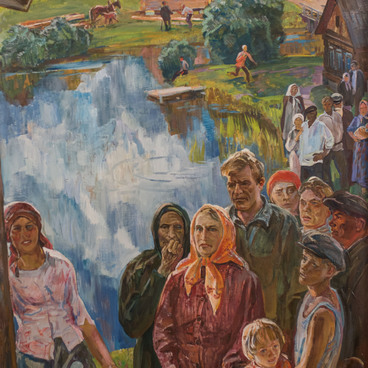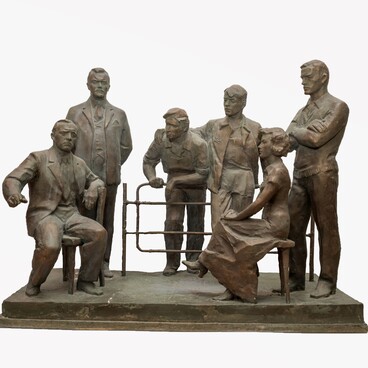Andey Plotnov painted the “Memory of Heroism” in 1985 and dedicated it to the Second World War. This is a genre scene with an evening landscape in the background.
On the left side, a girl puts flowers on a hill with remnants of a pillbox — a concrete dug-in guard-post. On the right, a pioneer with a bugle stands together with a group of young Budennovites with red banners and a veteran of the war who also comes to honor the memory of fellow soldiers killed in battles.
The very first pillboxes appeared in the First World War. They were used only to defend an area. The blockhouse could be either a single guard-post or one of many as a part of a fortified area. It protected soldiers from bullets, shrapnel, mines and shells and helped to shoot at the enemy through embrasures. Old tanks buried in the ground and tank towers set on pedestals were sometimes used as blockhouses.
Andrey Plotnov was born in 1916 in a peasant family in the village of Verkhneye Pavlovo of Dankovsky District, Lipetsk Oblast. He studied at a rural school and in 1932, moved to Moscow with his family. In 1933, he entered the Art College of the State Association of Publishers of Books and Magazines.
At the beginning of the war, as a fifth-year student, Plotnov joined the Moscow militia. In October 1941, he, along with other students, was taken off the front to complete his education. Having defended his thesis work in 1943, Plotnov, a member of the Moscow Union of Artists, became a military artist of the Studio at the Main Political Directorate of the Border Troops.
He created studies, often went to the front line where painted sketches of military fights and portraits of Red Army soldiers. Plotnov went to Kursk, Odessa, Sevastopol and many other front lines. Over this period, he painted more than 20 posters glorifying the Red Army and military posters “TASS Windows” (a series of posters created by a group of Soviet artists).
In the 1950s–1980s, Plotnov created dozens of paintings dedicated to the heroism of the Soviet people in the war and the labor enthusiasm of his fellow countrymen in the post-war period. He traveled around the USSR — the Kuril Islands and the western borders, the polar regions and the city of Kushka and the southernmost part of the USSR; he also visited Europe, the USA, the Middle East and Japan.
On the left side, a girl puts flowers on a hill with remnants of a pillbox — a concrete dug-in guard-post. On the right, a pioneer with a bugle stands together with a group of young Budennovites with red banners and a veteran of the war who also comes to honor the memory of fellow soldiers killed in battles.
The very first pillboxes appeared in the First World War. They were used only to defend an area. The blockhouse could be either a single guard-post or one of many as a part of a fortified area. It protected soldiers from bullets, shrapnel, mines and shells and helped to shoot at the enemy through embrasures. Old tanks buried in the ground and tank towers set on pedestals were sometimes used as blockhouses.
Andrey Plotnov was born in 1916 in a peasant family in the village of Verkhneye Pavlovo of Dankovsky District, Lipetsk Oblast. He studied at a rural school and in 1932, moved to Moscow with his family. In 1933, he entered the Art College of the State Association of Publishers of Books and Magazines.
At the beginning of the war, as a fifth-year student, Plotnov joined the Moscow militia. In October 1941, he, along with other students, was taken off the front to complete his education. Having defended his thesis work in 1943, Plotnov, a member of the Moscow Union of Artists, became a military artist of the Studio at the Main Political Directorate of the Border Troops.
He created studies, often went to the front line where painted sketches of military fights and portraits of Red Army soldiers. Plotnov went to Kursk, Odessa, Sevastopol and many other front lines. Over this period, he painted more than 20 posters glorifying the Red Army and military posters “TASS Windows” (a series of posters created by a group of Soviet artists).
In the 1950s–1980s, Plotnov created dozens of paintings dedicated to the heroism of the Soviet people in the war and the labor enthusiasm of his fellow countrymen in the post-war period. He traveled around the USSR — the Kuril Islands and the western borders, the polar regions and the city of Kushka and the southernmost part of the USSR; he also visited Europe, the USA, the Middle East and Japan.




